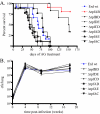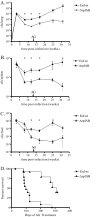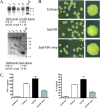A Mycobacterium tuberculosis Rpf double-knockout strain exhibits profound defects in reactivation from chronic tuberculosis and innate immunity phenotypes
- PMID: 18591237
- PMCID: PMC2519441
- DOI: 10.1128/IAI.01735-07
A Mycobacterium tuberculosis Rpf double-knockout strain exhibits profound defects in reactivation from chronic tuberculosis and innate immunity phenotypes
Abstract
Resuscitation-promoting factors (Rpfs), apparent peptidoglycan hydrolases, have been implicated in the reactivation of dormant bacteria. We previously demonstrated that deletion of rpfB impaired reactivation of Mycobacterium tuberculosis in a mouse model. Because M. tuberculosis encodes five Rpf paralogues, redundant functions among the family members might obscure rpf single-knockout phenotypes. A series of rpf double knockouts were therefore generated. One double mutant, DeltarpfAB, exhibited several striking phenotypes. Consistent with the proposed cell wall-modifying function of Rpfs, DeltarpfAB exhibited an altered colony morphology. Although DeltarpfAB grew comparably to the parental strain in axenic culture, in vivo it exhibited deficiency in reactivation induced in C57BL/6 mice by the administration of nitric oxide synthase inhibitor (aminoguanidine) or by CD4(+) T-cell depletion. Notably, the reactivation deficiency of DeltarpfAB was more severe than that of DeltarpfB in aminoguanidine-treated mice. A similar deficiency was observed in DeltarpfAB reactivation from a drug-induced apparently sterile state in infected NOS2(-/-) mice upon cessation of antimycobacterial therapy. Secondly, DeltarpfAB showed a persistence defect not seen with the DeltarpfB or DeltarpfA single mutants. Interestingly, DeltarpfAB exhibited impaired growth in primary mouse macrophages and induced higher levels of the proinflammatory cytokines tumor necrosis factor alpha and interleukin 6. Simultaneous reintroduction of rpfA and rpfB into the double-knockout strain complemented the colony morphology and macrophage cytokine secretion phenotypes. Phenotypes related to cell wall composition and macrophage responses suggest that M. tuberculosis Rpfs may influence the outcome of reactivation, in part, by modulating innate immune responses to the bacterium.
Figures









Similar articles
-
Deletion of the Mycobacterium tuberculosis resuscitation-promoting factor Rv1009 gene results in delayed reactivation from chronic tuberculosis.Infect Immun. 2006 May;74(5):2985-95. doi: 10.1128/IAI.74.5.2985-2995.2006. Infect Immun. 2006. PMID: 16622237 Free PMC article.
-
The resuscitation-promoting factors of Mycobacterium tuberculosis are required for virulence and resuscitation from dormancy but are collectively dispensable for growth in vitro.Mol Microbiol. 2008 Feb;67(3):672-84. doi: 10.1111/j.1365-2958.2007.06078.x. Mol Microbiol. 2008. PMID: 18186793 Free PMC article.
-
The role of resuscitation promoting factors in pathogenesis and reactivation of Mycobacterium tuberculosis during intra-peritoneal infection in mice.BMC Infect Dis. 2007 Dec 17;7:146. doi: 10.1186/1471-2334-7-146. BMC Infect Dis. 2007. PMID: 18086300 Free PMC article.
-
Resuscitation-promoting factors (Rpf): in search of inhibitors.Protein Pept Lett. 2012 Oct;19(10):1026-34. doi: 10.2174/092986612802762723. Protein Pept Lett. 2012. PMID: 22533619 Review.
-
Resuscitation-promoting factors as lytic enzymes for bacterial growth and signaling.FEMS Immunol Med Microbiol. 2010 Feb;58(1):39-50. doi: 10.1111/j.1574-695X.2009.00606.x. Epub 2009 Sep 4. FEMS Immunol Med Microbiol. 2010. PMID: 19799629 Review.
Cited by
-
Pathogenesis, immunology, and diagnosis of latent Mycobacterium tuberculosis infection.Clin Dev Immunol. 2011;2011:814943. doi: 10.1155/2011/814943. Epub 2010 Dec 27. Clin Dev Immunol. 2011. PMID: 21234341 Free PMC article. Review.
-
Detection of differentially culturable tubercle bacteria in sputum using mycobacterial culture filtrates.Sci Rep. 2021 Mar 22;11(1):6493. doi: 10.1038/s41598-021-86054-z. Sci Rep. 2021. PMID: 33753820 Free PMC article.
-
Interaction and modulation of two antagonistic cell wall enzymes of mycobacteria.PLoS Pathog. 2010 Jul 29;6(7):e1001020. doi: 10.1371/journal.ppat.1001020. PLoS Pathog. 2010. PMID: 20686708 Free PMC article.
-
Expression of Resuscitation-Promoting Factor C Stimulates the Growth of Mycobacterium bovis BCG and Delays DevR Regulon Activation in Hypoxia.Int J Microbiol. 2025 Feb 17;2025:2139933. doi: 10.1155/ijm/2139933. eCollection 2025. Int J Microbiol. 2025. PMID: 39996126 Free PMC article.
-
The ppm operon is essential for acylation and glycosylation of lipoproteins in Corynebacterium glutamicum.PLoS One. 2012;7(9):e46225. doi: 10.1371/journal.pone.0046225. Epub 2012 Sep 28. PLoS One. 2012. PMID: 23029442 Free PMC article.
References
-
- Bardarov, S., S. Bardarov, Jr., M. S. Pavelka, Jr., V. Sambandamurthy, M. Larsen, J. Tufariello, J. Chan, G. Hatfull, and W. R. Jacobs, Jr. 2002. Specialized transduction: an efficient method for generating marked and unmarked targeted gene disruptions in Mycobacterium tuberculosis, M. bovis BCG and M. smegmatis. Microbiology 1483007-3017. - PubMed
-
- Berg, C. M., N. B. Vartak, G. Wang, X. Xu, L. Liu, D. J. MacNeil, K. M. Gewain, L. A. Wiater, and D. E. Berg. 1992. The m gamma delta-1 element, a small gamma delta (Tn1000) derivative useful for plasmid mutagenesis, allele replacement and DNA sequencing. Gene 1139-16. - PubMed
-
- Cohen-Gonsaud, M., P. Barthe, C. Bagneris, B. Henderson, J. Ward, C. Roumestand, and N. H. Keep. 2005. The structure of a resuscitation-promoting factor domain from Mycobacterium tuberculosis shows homology to lysozymes. Nat. Struct. Mol. Biol. 12270-273. - PubMed
Publication types
MeSH terms
Substances
Grants and funding
LinkOut - more resources
Full Text Sources
Other Literature Sources
Medical
Research Materials

